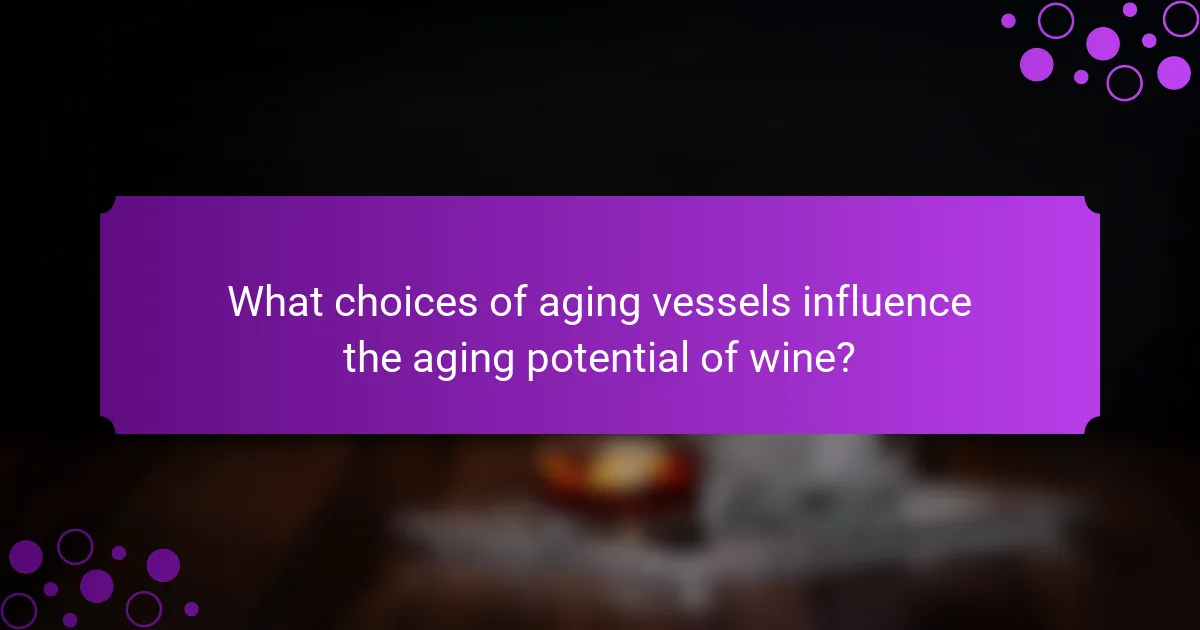
What is the Aging Potential of Limited Edition Wine?
The aging potential of limited edition wine is typically higher than that of standard wines. Limited edition wines are often crafted with superior grapes and meticulous winemaking practices. These factors contribute to a wine’s ability to develop complex flavors over time. The aging potential can range from several years to decades, depending on the varietal and production methods. For instance, Cabernet Sauvignon and Bordeaux blends are known for their long aging potential. Studies have shown that wines with higher tannin levels and acidity generally age better. Proper storage conditions further enhance the aging process. Therefore, limited edition wines are often sought after for their potential to improve with age.
How does aging affect the quality of limited edition wine?
Aging positively affects the quality of limited edition wine. Over time, chemical reactions occur that enhance flavors and aromas. Tannins soften, leading to a smoother mouthfeel. Acidity balances, making the wine more harmonious. The aging process often develops complex notes, such as earthy or fruity characteristics. Limited edition wines, crafted with high-quality grapes, tend to age better. Studies show that certain vintages improve significantly after several years. For instance, wines from renowned regions like Bordeaux can reach peak quality after a decade or more. These changes contribute to the wine’s overall complexity and desirability.
What chemical changes occur during the aging process?
During the aging process, wine undergoes several chemical changes. These changes include the oxidation of phenolic compounds, which can enhance flavor complexity. Tannins also polymerize, leading to a smoother mouthfeel. Additionally, esters and aldehydes form, contributing to the wine’s aromatic profile. The acidity of wine may decrease over time, affecting its balance. Furthermore, volatile compounds can evaporate, altering the wine’s bouquet. The interactions between compounds in the wine evolve, resulting in a unique character. These changes are influenced by factors such as temperature, light exposure, and the type of aging vessel used.
How does aging influence flavor and aroma profiles?
Aging significantly alters flavor and aroma profiles in wine. As wine ages, chemical compounds evolve, enhancing complexity. Tannins soften, leading to smoother textures. This process often introduces secondary flavors, such as nutty or caramel notes. Aromas can shift from fruity to earthy or floral as volatile compounds change. Oxygen exposure during aging also contributes to these transformations. Studies indicate that older wines often exhibit greater depth and balance. For instance, research by the University of California highlights how aging can enhance desirable aromatic compounds.
Why are winemaking practices important for aging potential?
Winemaking practices are crucial for aging potential because they influence the wine’s chemical composition and structure. Techniques such as fermentation temperature and duration affect flavor development and acidity. The choice of aging vessels, like oak barrels, imparts tannins and oxygen exposure, which can enhance complexity. Additionally, practices like malolactic fermentation soften acidity, making the wine more palatable over time. Research indicates that wines with balanced acidity and tannin structure age better, as seen in studies of Bordeaux wines. These factors collectively determine how well a wine can evolve and develop desirable characteristics over years.
What specific winemaking techniques enhance aging potential?
Specific winemaking techniques that enhance aging potential include extended maceration, barrel aging, and careful selection of grape varieties. Extended maceration allows for greater extraction of tannins and phenolic compounds, which contribute to structure and longevity. Barrel aging, particularly in oak barrels, introduces oxygen gradually and adds complexity through flavor compounds. The choice of grape varieties also plays a crucial role; varieties with higher acidity and tannin levels tend to age better. Research indicates that wines aged in quality barrels can show improved aging potential due to the micro-oxygenation process. These techniques collectively create a balanced and robust wine that can develop favorable characteristics over time.
How do vineyard conditions impact the aging potential of wine?
Vineyard conditions significantly impact the aging potential of wine. Factors such as soil composition, climate, and grape variety play crucial roles. Well-drained soils can promote healthy root systems, leading to better grape quality. Climate influences the ripening process, affecting sugar and acidity levels in grapes. Optimal sugar and acidity balance is essential for aging. Varieties like Cabernet Sauvignon age better in warmer climates due to their thicker skins. Additionally, vineyard altitude can affect temperature fluctuations, which are beneficial for developing complex flavors. Research shows that wines from regions with consistent climate patterns tend to age more gracefully. For instance, wines from Bordeaux often exhibit superior aging potential due to ideal vineyard conditions.

What role do fermentation techniques play in aging potential?
Fermentation techniques significantly influence the aging potential of wine. These techniques affect the chemical composition of the wine, which impacts its stability and flavor development over time. For example, controlled fermentation temperatures can enhance the preservation of desirable aromas and flavors. Additionally, the use of specific yeast strains can contribute to the complexity of the wine, leading to a more nuanced profile as it ages.
Research shows that wines fermented with indigenous yeasts often exhibit greater aging potential due to their unique interactions with the wine’s compounds. Moreover, techniques like malolactic fermentation can soften acidity and add richness, making the wine more rounded as it matures. The choice of fermentation vessels, such as oak barrels, also plays a crucial role in introducing tannins and oxygen, which can further enhance aging characteristics.
In summary, fermentation techniques are vital in determining a wine’s aging potential by influencing its chemical makeup and flavor complexity.
How does fermentation impact the aging process of wine?
Fermentation significantly influences the aging process of wine. During fermentation, yeast converts sugars into alcohol and produces various compounds that impact flavor and aroma. These compounds include esters and phenols, which contribute to a wine’s complexity. The fermentation temperature and duration can also affect the wine’s texture and mouthfeel.
Malolactic fermentation, a secondary fermentation process, softens acidity and adds buttery notes. This process can enhance the aging potential of certain wines. Additionally, fermentation can influence the extraction of tannins from grape skins, which play a crucial role in a wine’s structure and aging ability.
Research indicates that wines with higher tannin levels generally age better. The interaction between fermentation and tannins can lead to a more robust aging profile. Overall, fermentation sets the foundation for how a wine will evolve over time, affecting its longevity and flavor development.
What are the different fermentation methods used in winemaking?
The different fermentation methods used in winemaking include spontaneous fermentation, controlled fermentation, and malolactic fermentation. Spontaneous fermentation relies on wild yeast present in the environment. This method can produce unique flavors but may lead to unpredictable results. Controlled fermentation uses cultivated yeast strains to ensure consistency. This method allows winemakers to manage the fermentation process more precisely. Malolactic fermentation is a secondary fermentation that converts malic acid into lactic acid. This process can soften the wine’s acidity and enhance complexity. Each method influences the wine’s flavor profile and aging potential.
How do yeast strains affect the aging characteristics of wine?
Yeast strains significantly influence the aging characteristics of wine. Different yeast strains impart unique flavors and aromas during fermentation. These strains also affect the wine’s acidity and tannin structure. For example, Saccharomyces cerevisiae is commonly used for its reliable fermentation and ability to enhance fruity notes. Non-Saccharomyces yeasts can contribute complexity and additional layers of flavor. The choice of yeast can impact the wine’s mouthfeel and overall balance. Research shows that specific yeast strains can promote the development of beneficial compounds during aging. This results in a more nuanced and refined wine profile over time.
What is the significance of malolactic fermentation in aging?
Malolactic fermentation is significant in aging wine as it transforms harsh malic acid into softer lactic acid. This process enhances the wine’s mouthfeel and stability. It also contributes to the development of complex flavors, such as buttery or creamy notes. Malolactic fermentation can reduce acidity, making the wine more approachable. It is commonly employed in red wines and some white wines, like Chardonnay. The timing of this fermentation affects the aging potential and overall profile of the wine. Research indicates that wines undergoing malolactic fermentation often exhibit improved aging characteristics. This fermentation is a crucial winemaking practice that influences the final product’s quality and longevity.
How does malolactic fermentation contribute to the aging process?
Malolactic fermentation (MLF) significantly contributes to the aging process of wine. MLF converts harsh malic acid into softer lactic acid, enhancing the wine’s mouthfeel. This process reduces acidity, making the wine smoother and more palatable. Additionally, MLF can introduce complexity and depth of flavor. Compounds such as diacetyl, which adds a buttery note, are produced during MLF. The occurrence of MLF often leads to a more stable wine, improving its aging potential. Wines that undergo MLF typically develop better aromatic profiles over time. Research shows that wines with MLF exhibit greater integration of flavors and improved texture as they age.
What flavors are developed through malolactic fermentation?
Malolactic fermentation develops flavors such as butter, cream, and nutty characteristics. This process converts malic acid into lactic acid. It softens the wine’s acidity and enhances mouthfeel. Additionally, it can introduce flavors of vanilla and toasty notes from oak aging. These flavors are often found in Chardonnay and some red wines. The transformation occurs due to specific bacteria, primarily Oenococcus oeni. This fermentation is a common practice in winemaking to achieve a rounder profile.

What choices of aging vessels influence the aging potential of wine?
The choices of aging vessels significantly influence the aging potential of wine. Common aging vessels include oak barrels, stainless steel tanks, and concrete eggs. Oak barrels impart flavors and tannins to the wine. The size of the barrel affects the wine’s exposure to oxygen. Smaller barrels enhance oxidation, leading to complex flavors. Stainless steel tanks preserve the wine’s fresh fruit character. They prevent oxygen contact, maintaining acidity and brightness. Concrete eggs provide a unique micro-oxygenation effect. This can enhance texture and mouthfeel. Each vessel’s material and shape contribute to the wine’s overall profile. Studies show that barrel-aged wines often develop more complexity over time.
How do different types of aging vessels affect wine quality?
Different types of aging vessels significantly affect wine quality. Oak barrels impart flavors and tannins, enhancing complexity. Stainless steel preserves freshness and acidity, maintaining fruit flavors. Concrete tanks provide micro-oxygenation, fostering texture and mouthfeel. Glass vessels offer a neutral environment, allowing pure expression of the wine’s characteristics. The choice of vessel influences oxidation rates, which can affect aging potential. Research shows that wines aged in oak develop more aromatic compounds, while those in stainless steel retain higher acidity levels. Each vessel type brings unique attributes that shape the final wine profile.
What are the characteristics of oak barrels versus stainless steel tanks?
Oak barrels are porous, allowing for oxygen exchange and imparting flavors to the wine. The wood contributes tannins, vanillin, and other aromatic compounds. This process enhances complexity and mouthfeel in the wine. Oak barrels also provide a micro-oxygenation effect, which can soften tannins and stabilize color.
In contrast, stainless steel tanks are non-porous and do not allow oxygen transfer. They maintain the wine’s pure fruit flavors without additional wood influence. Stainless steel also offers precise temperature control during fermentation and aging. This vessel is ideal for preserving freshness and acidity in wines.
The choice between oak barrels and stainless steel tanks significantly impacts the final wine profile. Studies show that wines aged in oak develop more complexity and richness. Conversely, wines in stainless steel tend to retain their varietal character and crispness.
How does the size of the aging vessel impact the wine’s aging process?
The size of the aging vessel significantly impacts the wine’s aging process. Smaller vessels have a higher surface area-to-volume ratio. This increases the wine’s exposure to oxygen. Enhanced oxygen exposure can accelerate oxidation and aging. Larger vessels provide a slower aging process. This is due to reduced oxygen interaction. The type of wood used in the vessel also matters. For example, smaller barrels impart more flavor compounds. Research shows that the aging vessel’s size affects tannin integration and flavor development. A study by the University of California, Davis, highlights these effects on various wine types.
What is the impact of aging vessel treatment on flavor development?
Aging vessel treatment significantly influences flavor development in wine. The type of vessel, such as oak barrels or stainless steel tanks, affects the wine’s final taste profile. Oak barrels impart flavors like vanilla, spice, and toast due to the compounds released during aging. These flavors come from the wood’s lignin and tannins. Stainless steel, on the other hand, preserves the wine’s fresh, fruity characteristics without adding additional flavors.
Research shows that the interaction between wine and the aging vessel can enhance complexity. For example, a study published in the Journal of Agricultural and Food Chemistry found that wines aged in oak exhibited higher levels of certain volatile compounds associated with desirable flavors. This demonstrates the impact of aging vessel treatment on flavor development.
How does the toasting level of oak barrels influence aging potential?
The toasting level of oak barrels significantly influences the aging potential of wine. Toasting refers to the process of heating the wood to enhance flavors and aromas. Lightly toasted barrels impart subtle vanilla and floral notes, while heavily toasted barrels contribute more intense flavors like chocolate and spice.
These flavor compounds interact with the wine during aging, affecting its complexity and aging potential. The toasting level also impacts the extraction of tannins and phenolic compounds. Higher levels of toast can lead to increased tannin integration, which can enhance the wine’s structure and longevity.
Research indicates that the choice of toasting level can result in distinct sensory profiles after aging. For example, a study published in the Journal of Agricultural and Food Chemistry found that different toasting levels affected the phenolic composition of wine, influencing both taste and aging capacity. This evidence supports the conclusion that toasting levels play a crucial role in determining the aging potential of wine.
What role does the vessel’s previous use play in flavor impartation?
The vessel’s previous use significantly influences flavor impartation in wine. Used vessels often retain residual compounds from prior contents. These compounds can add complexity and unique flavors to the wine. For example, a barrel previously used for aging sherry may impart nutty and oxidative notes. This interaction occurs due to the porous nature of wood, which allows for micro-oxygenation. Additionally, the toasting level of the barrel can affect the flavor profile. Research indicates that different previous uses can lead to distinct sensory characteristics in the wine. Therefore, the history of a vessel is crucial in determining the final taste of the wine.
What best practices should winemakers follow for optimal aging potential?
Winemakers should focus on specific practices to enhance aging potential. Selecting high-quality grapes is essential, as they contribute to the wine’s structure and complexity. Controlled fermentation temperatures help preserve delicate aromas and flavors. Utilizing oak barrels can add beneficial tannins and enhance the wine’s aging profile. Regular monitoring of wine chemistry, including acidity and sulfite levels, ensures stability over time. Proper storage conditions, such as consistent temperature and humidity, prevent spoilage and oxidation. Additionally, minimizing oxygen exposure during bottling and storage protects the wine’s integrity. These practices collectively support the development of desirable characteristics in aged wines.
How can winemakers monitor and adjust aging conditions effectively?
Winemakers can monitor and adjust aging conditions effectively by utilizing temperature and humidity control systems. These systems ensure optimal storage environments for wine maturation. Regularly measuring and adjusting temperature within the range of 55-65°F is crucial for proper aging. Humidity levels should be maintained between 60-70% to prevent cork drying and oxidation.
Winemakers also employ sensory analysis to evaluate wine development over time. Tasting samples at different aging stages provides insights into flavor and aroma evolution. Additionally, using laboratory analysis helps in assessing chemical changes, such as acidity and phenolic compounds.
Monitoring oxygen exposure is vital; winemakers can use inert gas systems to limit oxidation. The choice of aging vessel, whether oak barrels or stainless steel tanks, significantly influences aging outcomes. Each vessel type imparts different characteristics to the wine, which winemakers can adjust based on desired profiles.
By combining these methods, winemakers can effectively manage aging conditions and enhance the final quality of the wine.
What common mistakes should be avoided during the aging process?
Common mistakes to avoid during the aging process of limited edition wine include improper storage conditions. Wines should be stored in a consistent, cool temperature, ideally between 50-55°F. Fluctuating temperatures can spoil the wine. Additionally, exposure to light can degrade wine quality. It is crucial to store wine in a dark place or use UV-protective bottles. Humidity levels also matter; too low humidity can dry out corks, leading to oxidation. Using the wrong type of aging vessel can negatively affect the wine’s flavor profile. For example, using overly porous materials can introduce unwanted oxygen. Lastly, failing to monitor the aging process can result in over-aging, which diminishes wine quality. These practices are essential for preserving the wine’s intended character and complexity.
The main entity of this article is the aging potential of limited edition wine. This article provides a comprehensive overview of how winemaking practices, fermentation techniques, and choices of aging vessels influence the aging potential and quality of limited edition wines. Key topics include the chemical changes that occur during aging, the impact of vineyard conditions, and the significance of specific fermentation methods such as malolactic fermentation. Additionally, the article discusses best practices for winemakers to enhance aging potential and common mistakes to avoid during the aging process.